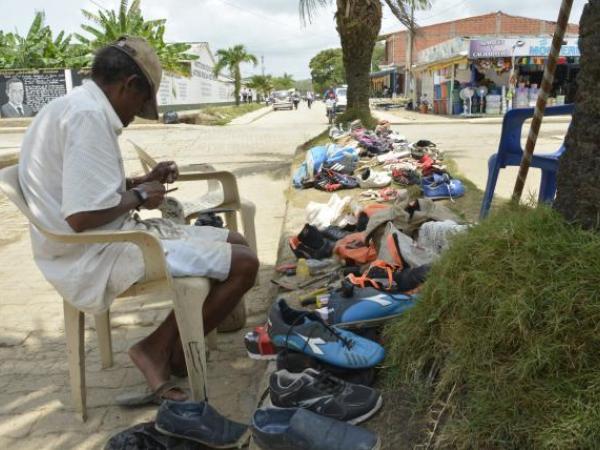The Dane revealed on Wednesday – February 12 – the consolidated labor informality in Colombia by 2024, in which it is appreciated that this scourge remains at the same levels as a year earlier and that although the increases observed in Several moments, more than half of the employment generated in local market, It does not comply with the standards required by national legislation.
Proof of this is that according to the data presented, in the quarter October-December 2024, 55.8% of those occupied in Colombia were informal. If one takes into account that for the same period of 2023, this indicator was In 55.5%, it is clear that advances in the matter were null in the last 12 months.
More information: Fiscal Rule: Transactions once would go against Confis concepts
“In the 13 cities and metropolitan areas this proportion was 42.5%, while in the quarter October – December 2023 it was 41.5%. In the case of the total of the 23 cities and metropolitan areas, the proportion of informality was 43.8%, ”said the DANE.
On the other hand, although the main cities are maintained Below the national average, Dane accounts reaffirm that the most remote populations of the country and the rural sector remain the main generators of informal jobs, since there, this indicator remained at 82.8%.
Labor informality
Archive time
“For the national total, the proportion of informal men in the quarter October – December 2024 was 57.3%, while 53.6% of women were occupied informal. For the 13 cities and metropolitan areas, in the quarter October – December 2024 the proportion of informal women was 42.4%, while for this same period the proportion of informal men was 42.5%, ”added the statistical authority.
Cities review
The Dane also counted when reviewing the informality by regions, of the 23 cities and metropolitan areas, those that presented a greater proportion of informality were sincelejo (68.2%), Cúcuta (63.8%), Valledupar (63.0%), Riohacha (61.8%) and Santa Marta (61.3%); All above the national average.
Meanwhile, when reviewing the areas with lower informality reports, it is observed that Manizales (34.2%), Pereira (35.9%), Bogotá (36.4%), Tunja (38.3%), Medellín (Medellín (Medellín (Medellín ( 38.7%) and Armenia (43.3%); They have the lowest records, even below the average.
Other news: Colombian coffee maintains its good streak: price of the pound reached US $ 4.20
“In the national total, for the quarter October – December 2024 84.6% From the employed population that worked in microenterprises, it was informal, while in a small company, medium -sized company and large company the proportion of informal employed was: 21.0%, 4.5%and 2.8%, respectively, ”they reported.
Changing focus and reviewing the national total, but in the period January – December 2024, the DANE said that the proportion of informal employed people was 55.9%, representing a decrease of 0.5 percentage points compared to the previous year, when It had remained at 56.4%.

Labor informality
Archive time
“On the other hand, in the 13 cities and metropolitan areas this proportion was 41.9%, compared to the period January – December 2023 (41.7%). For the total of the 23 cities and metropolitan areas, the proportion of informality was 43.2%. In front of populated and rural centers The proportion of informality for the year January – December 2024 was 83.9%, ”he said.
This report also appreciates that, for the 12 -month review, “Sincelejo (68.2%), Cúcuta (61.9%) and Riohacha (61.5%), have the highest reports; While the cities with the lowest proportion of informality were: Manizales (34.0%), Bogotá DC (34.6%) and Medellín (38.4%) ”.
It may interest you: Trump communicates with Putin to negotiate and seek the end of the war with Ukraine
Gender gaps
The National Statistics Administrative Department also revealed The Labor Market Report according to sex and there shows that gender gaps in the labor market persist, reflecting structural inequality in access to employment, since in the quarter October-December 2024, the female unemployment rate was 11.2%, while the male was 7.1%, showing a difference of 4.1 percentage points in the unemployment rate.
If one takes into account that a year ago the unemployment rate for men was 7.6% and that of women of 11.6%, maintaining the difference of 4 percentage points between the two categories, it is clear that in this front there were also no Greater advances in the last 12 months, in the face of access difference for each sex.

Gender gaps.
Istock
Similarly, women also face lower opportunities for labor participation, since the global participation rate showed a difference of 23.6 percentage points Between men and women, while the gap in the occupation rate was 24.1 points.
Meanwhile, the situation is even more critical in rural areas, where the gap in the unemployment rate reached 5.8 percentage points, the highest among the different geographical domains.
Read here: Possible trains clash between carf and minhacienda turns on alerts in the market
“For the period January – December 2024, the unemployment rate for women It was 12.7%, while in January – December 2023 it was 12.8%. For men, TD was 8.2%, staying equal to that registered during the previous year. For its part, the occupation rate was 70.1% for men and 45.7% for women, ”said the DANE.
As for labor distribution, women are mainly concentrated in the vehicle trade and repair sectors (1.9 million), public administration, education and health (1.74 million), and artistic and recreational activities (1.38 millions).
Finally, occupational positions with the greatest female presence are private employment (4.45 million), self -employment (3.78 million) and domestic employment (668,000 workers).


















